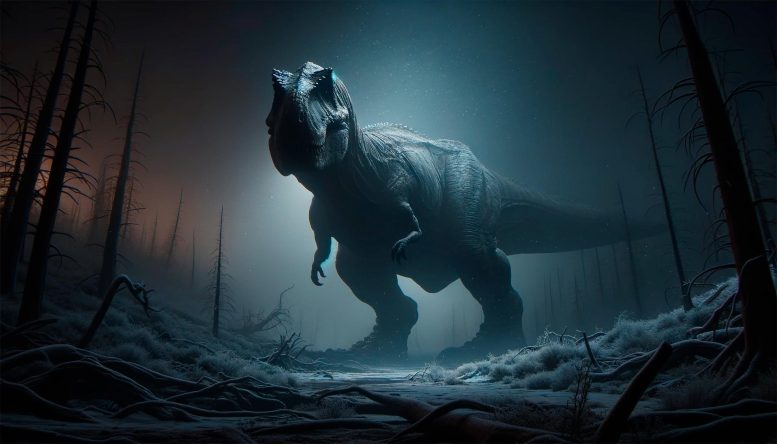
The Chicxulub impact, believed to have caused the mass extinction 66 million years ago, may have resulted in a 15°C global cooling, primarily due to micrometric silicate dust, according to a new study from the Royal Observatory of Belgium. This dust could have disrupted photosynthesis for almost two years, contributing to the extinction event.
Fine dust from pulverized rock generated by the Chicxulub impact likely played a dominant role in global climate cooling and the disruption of photosynthesis following the event. This is suggested by a new study published in Nature Geoscience, in which researchers Cem Berk Cenel, Özgür Karatekin, and Orkun Temel of the Royal Observatory of Belgium contributed.
The Chicxulub meteorite impact has long been thought to have triggered a global impact winter, which led to the demise of the dinosaurs and around 75% of species on Earth at the Cretaceous-Palaeogene (K-Pg) boundary 66 million years ago. However, what effect the various types of debris ejected from the crater had on the climate is debated, and exactly what caused the mass extinction remains unclear.
Previous research has suggested that sulfur released during the impact and soot from post-impact wildfires constituted the main drivers of an impact winter, and not the ejection of silicate dust into the atmosphere. However, this hypothesis was based so far on a limited knowledge of the actual size properties of the dust particles.
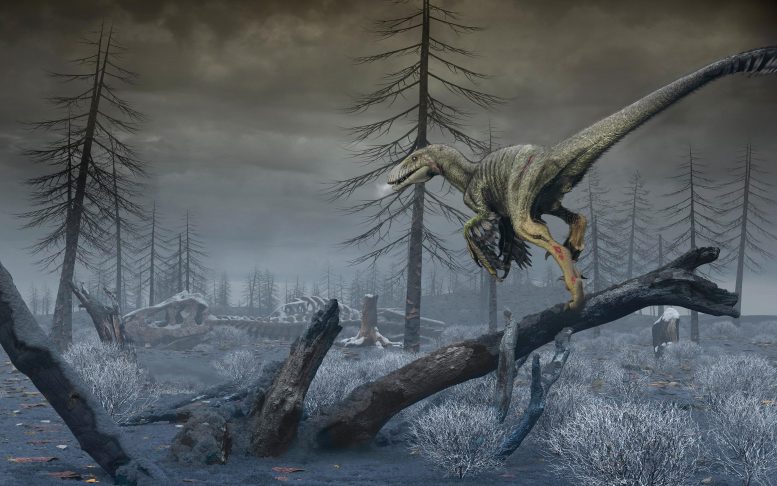
Paleoart reconstruction depicting North Dakota in the first months following the Chicxulub impact event 66 million years ago, showing a dark, dusty, and cold world in which the last non-avian dinosaurs, illustrated with a Dakotaraptor steini, were on the edge of extinction. Credit: Mark A. Garlick
New Insights from the Royal Observatory of Belgium
To evaluate the roles of sulfur, soot, and silicate dust on the post-impact climate, Cem Berk Senel, Orkun Temel, and Özgür Karatekin, scientists from the Royal Observatory of Belgium (ROB), developed a new paleoclimate model, specialized to simulate the climate and biotic response following the Chicxulub impact. These simulations were carried out by incorporating new, high-resolution geological field data from a location in North Dakota, USA.
Sediment samples were collected and measured using laser-diffraction grain-size analysis by Pim Kaskes and colleagues at Archaeology, Environmental Changes & Geo-chemistry (AMGC) at the Vrije Universiteit Brussel (VUB) and the Vrije Universiteit Amsterdam (VUA).
“We specifically sampled the uppermost millimeter-thin interval of the Cretaceous-Paleogene boundary layer. This interval revealed a very fine and uniform grain-size distribution, which we interpret to represent the final atmospheric fall-out of ultrafine dust related to the Chicxulub impact event. The new results show much finer grain-size values than previously used in climate models and this aspect had important consequences for our climate reconstructions,” explains Kaskes.
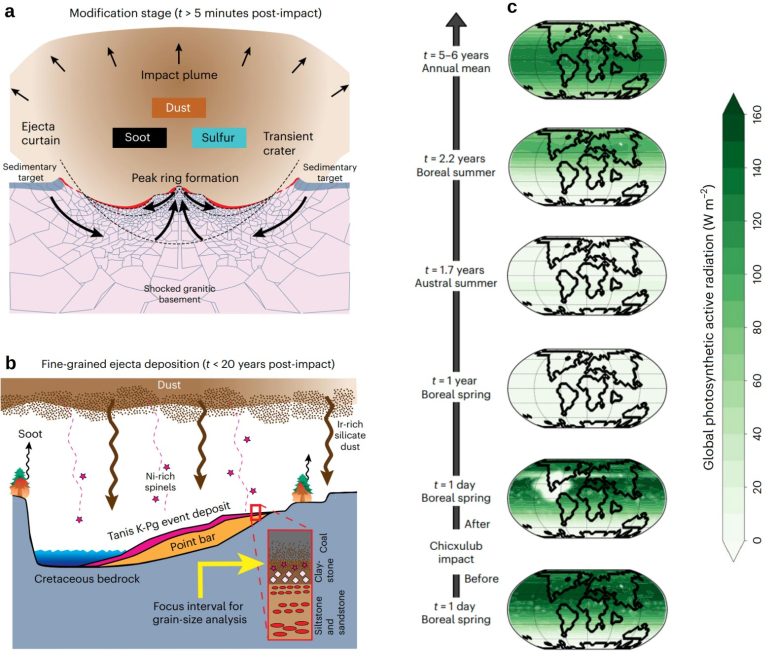
Conceptual model of the Chicxulub impact plume showing different stages of (a) production, and (b) transport and deposition of the impact-generated ejecta (not to scale). (c) Paleoclimate model simulations showcasing the time evolution of the dust-induced photosynthetic active radiation flux across the planet following the Chicxulub impact 66 million years ago. Credit: Modified from Senel et al., 2023; Nature Geoscience
The Role of Silicate Debris
The researchers discovered that the size distribution of silicate debris (approximately 0.8–8.0 µm) revealed a larger role for fine dust than previously appreciated.
Cem Berk Senel (ROB), the lead author, describes: “The new paleoclimate simulations show that such a plume of micrometric silicate dust could have remained in the atmosphere for up to 15 years after the event, contributing to global cooling of the Earth’s surface by as much as 15 °C in the initial aftermath of the impact.”
This timescale, according to co-authors Steven Goderis and Philippe Claeys (both VUB-AMGC), is consistent with the recent global iridium layer observations from the Chicxulub impact structure, where the final atmospheric settling of fine-grained impactor material in the dust cloud was estimated to be less than 20 years.
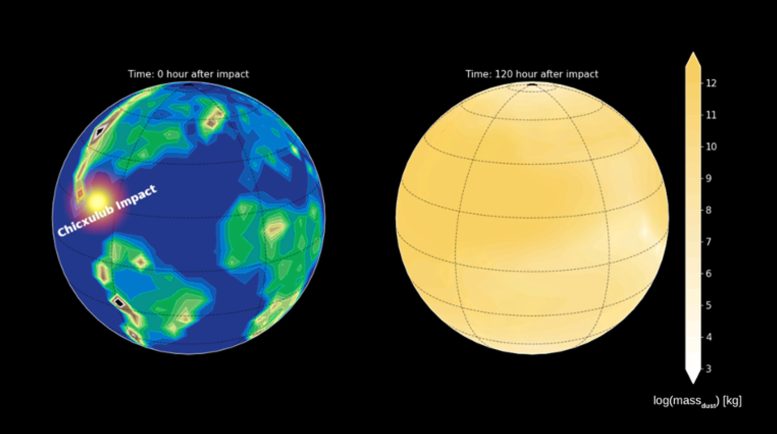
Paleoclimate model simulations show the rapid dust transport across the planet, indicating thatthe Paleogene world was encircled by the silicate dust ejecta within a few days following the Chicxulub impact event. Credit: Simulations by Cem Berk Senel
Furthermore, the authors find that dust-induced changes in solar irradiance may have shut down photosynthesis for almost two years post-impact. The prolonged disruption in photosynthesis constitutes a sufficiently long timescale to pose severe challenges for both terrestrial and marine habitats. Biotic groups that were not adapted to survive the dark, cold, and food-deprived conditions for almost two years would have experienced mass extinctions.
This matches the paleontological records, according to co-author Johan Vellekoop (KU Leuven and Royal Belgian Institute of Natural Sciences), which show that fauna and flora that could enter a dormant phase (for example, through seeds, cysts, or hibernation in burrows) and were able to adapt to an omnivorous diet, not dependent on one particular food source (for example, deposit feeders), generally better survived the K-Pg event.
The authors suggest that the silicate dust, along with soot and sulfur, played a major role in blocking photosynthesis and sustaining an impact winter long enough to cause the catastrophic collapse of primary productivity, triggering a chain reaction of extinctions.
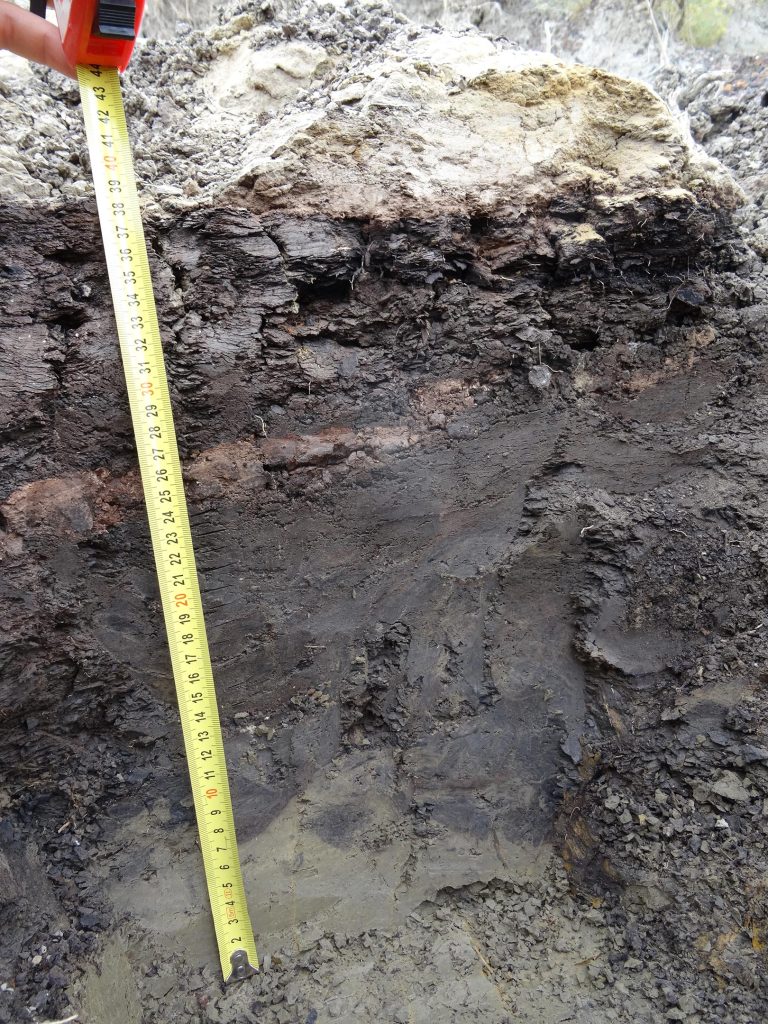
Overview of the Cretaceous-Paleogene boundary in North Dakota (USA). The sediments indicate a river and swamp-like environment at the end of the age of the dinosaurs. The pink-brown layer yields ejecta debris derived from the Chicxulub impact event and the grain-size data from this interval were used as input parameters for the paleoclimate modeling study. Credit: Pim Kaskes
Implications and Planetary Defense
“The Chicxulub-sized impacts by kilometer-sized asteroids causing mass extinction events are rare, however, small- and medium-sized asteroids in the range of 100 meters are far more common in the Solar System and can cause destruction on a regional to national scale,” says Özgür Karatekin (ROB).
The European Space Agency’s Hera asteroid mission for planetary defense is Europe’s contribution to an international planetary defense experiment to which authors of the present research from the Royal Observatory of Belgium and VUB are contributing. The Hera mission will validate the kinetic impactor asteroid deflection technique and provide scientific information, thereby increasing our understanding of asteroid geophysics and impact processes.
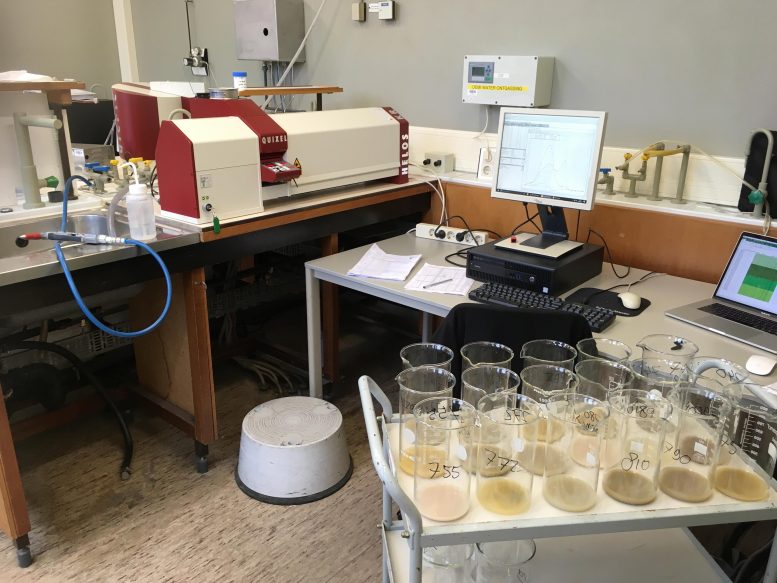
The HELOS laser-diffraction grain-size analyzer at the Sedimentology Lab of the Vrije Universiteit Amsterdam. This instrument was used to measure the size properties of the Cretaceous-Paleogene boundary sediments depicted in the foreground. Credit: Pim Kaskes
Reference: “Chicxulub impact winter sustained by fine silicate dust” by Cem Berk Senel, Pim Kaskes, Orkun Temel, Johan Vellekoop, Steven Goderis, Robert DePalma, Maarten A. Prins, Philippe Claeys and Özgür Karatekin, 30 October 2023, Nature Geoscience.
DOI: 10.1038/s41561-023-01290-4
This research has been supported by Belgian Federal Science Policy (BELSPO) through the Chicxulub BRAIN-be (Belgian Research Action through Interdisciplinary Networks) project, which is a collaboration between the Royal Observatory of Belgium, Vrije Universiteit Brussel, and the Royal Belgian Institute of Natural Sciences. The authors also acknowledge the support of Research Foundation-Flanders (FWO) grants as well as a FED-tWIN project.

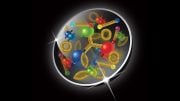

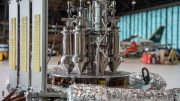

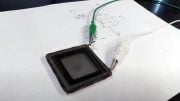
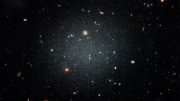
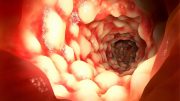
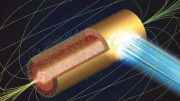
n
Every day theres anwser for dinosaur not allways real science how come many lizard are alive today who live with the dinosaur most are only tropical species that hate the night and cold look at the cridblety aviandinosaur anywon link birds with dinosaur knows nothing about dinosaur .let’s look at only dinosaur alive the spinosauridae dinosaur the gator it’s a specialize night hunter like most modern crocodilian it has cat eyes like a housecat the gator is a native North Carolina were they face artic weather every year it survive frozen pond
Every dinosaur today love the cold the spectacled caiman a very tropical species is invasive species now live in very warm subtropical southern Florida not warm enough for most reptile the sub name is big deal in the animal world .the reason why modern crocodilian love the cold because all came from the Nile crocodile it’s a native of the desert it get real cold at night in the desert it’s well known fact but some how I miss this fact and have known about this for years .
So to take cold is in their system .so not only a lack of epipygoid they share . So better dinosaur survive like other animal like what darwin said .we know that eoraptor has tuatara teeth which show that dinosaur was allways was primitive and is no match for superior dinosaur the mesoeucrocodylia dinosaur .eoraptor has archosauriformies teeth dinosaur does not have the great technology like the gator that still strong today they have large predator population today it could be higher because of human
There is nothing primitive about the great dinosaur the gator.the pterosaur dinosaur with bird occified sternum and bird furcula these complex is complete different the bird complex i thought it was one joint on furcula it’s 3 joint the furcua move to help breathe in flight in pterosaur all is fuse there is no joint they say complex is too thin for tendon a advance feature .that why furcula never in right place in bird fossil
The ads reset my work finish for the day
There is gap at hypocleidium furcula there is cartilidge and there is cartilidege at all the joint.I saw video of bird furcula moving and I never think about it .clearly there is a joint
The pterosaur dinosaur clearly convergent with birds because it’s fast very aquatic dinosaur .pterosaur has synsacrum like birds and fossil gator type mesoeucrocodylian clearly is a dinosaur .pterosaur toe claws are like land animal the finger claws are climbing animal I know that this I did not know allso for grasping
A pseudosuchus dinosaur allso has those unique claws it’s ankle peg is other side and has tetanuran dinosaur skull that is not bird like the ankle simular to gator but backward the peg these ankle clearly dinosaur type it show fusion but clearly they are not fuse the gator can sprawl .t.rex can not .they cliam this pseudosuchus dinosaur is not a dinosaur but has tetanuran skull like the gator they are not close related the gator is true tetanuran dinosaur.
The backward peg ankle pseudosuchus still has grasping claws like it’s dinosaur ancestor .pterosaur a bipedal dinosaur they said it walk like mammal the foot print show quadrupedalism and bipedalism it’s arm are large that not a bipedal feature birds are allso large the wing theropod and gator are small all are bipedal .the pterosaur lack a fourth traochanter some bird lack a furcula and still can fly because it’s built out mite be same for pterosaur when come to bipedalism
Pterosaur finger claws are grasping wresting predator feature like most theropod dinosaur predator it’s not for walking the wing are attach to the legs they are better off fully bipedal the early bird microraptor has wing leg they can sprawl there acetubular hip is not fully open not like theropod dinosaur for bird bipedalism is link to wing leg for pterosaur it’s allready a dinosaur so it never stop being bipedal.early bird like microraptor archaeopteryx leg wings are for flight for the early birds
Pterosaur first finger is not flight wing it’s 4th finger I thought it was first finger because theropod predator dinosaur thumb is biggest finger grasping feature in birds they lack a first finger or first toe. in birds 3 finger is the biggest allso in the early bird velociraptor likely this is wing finger .not all bird is like this some have second finger is the biggest a grasping finger.some have all finger as the same size or lack arm no wing the oviraptor bird has all finger as the same size
Pterosaur is an early dinosaur but it has advance feature it’s skull is like t.rex gharial it’s unique feature very rare in reptiles this future they want to use to identified reptile species .it’s allso found in birds it only found in one modern crocodilian allso found in proterosuchus dinosaur